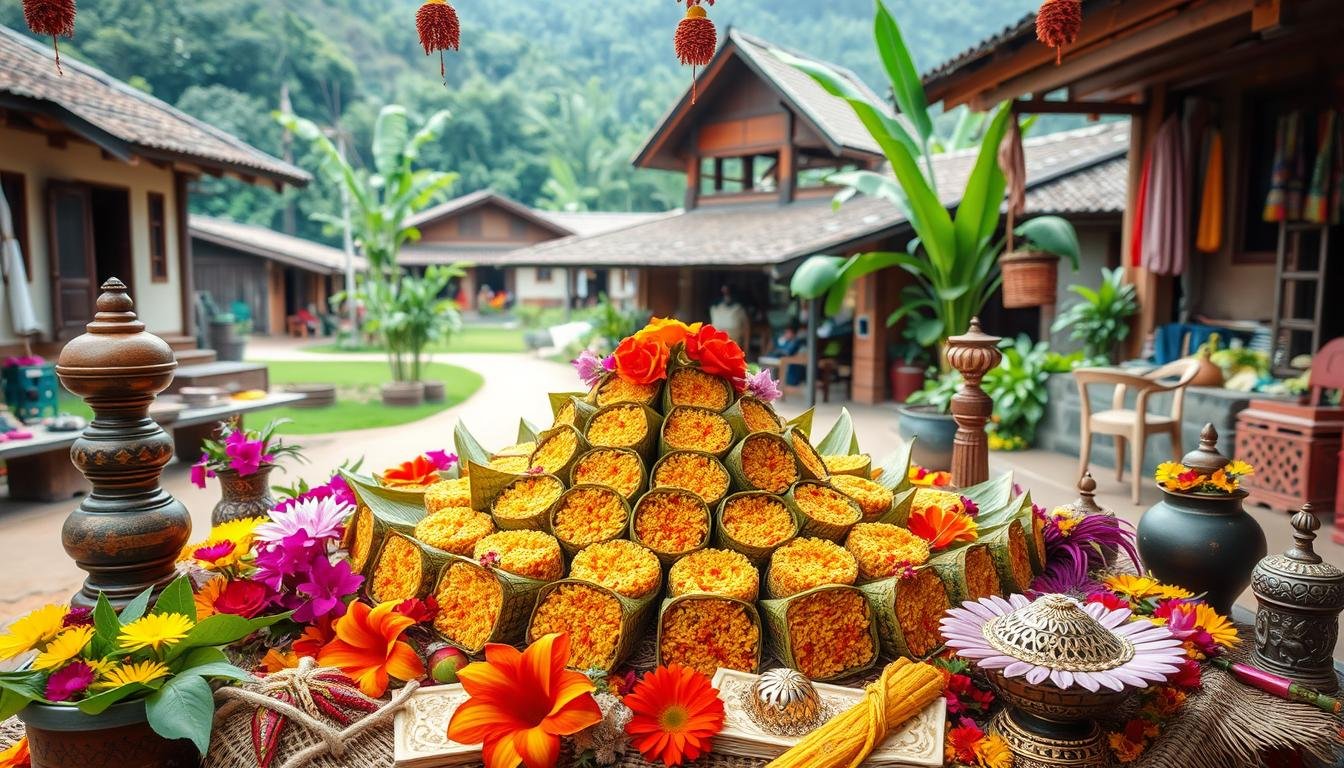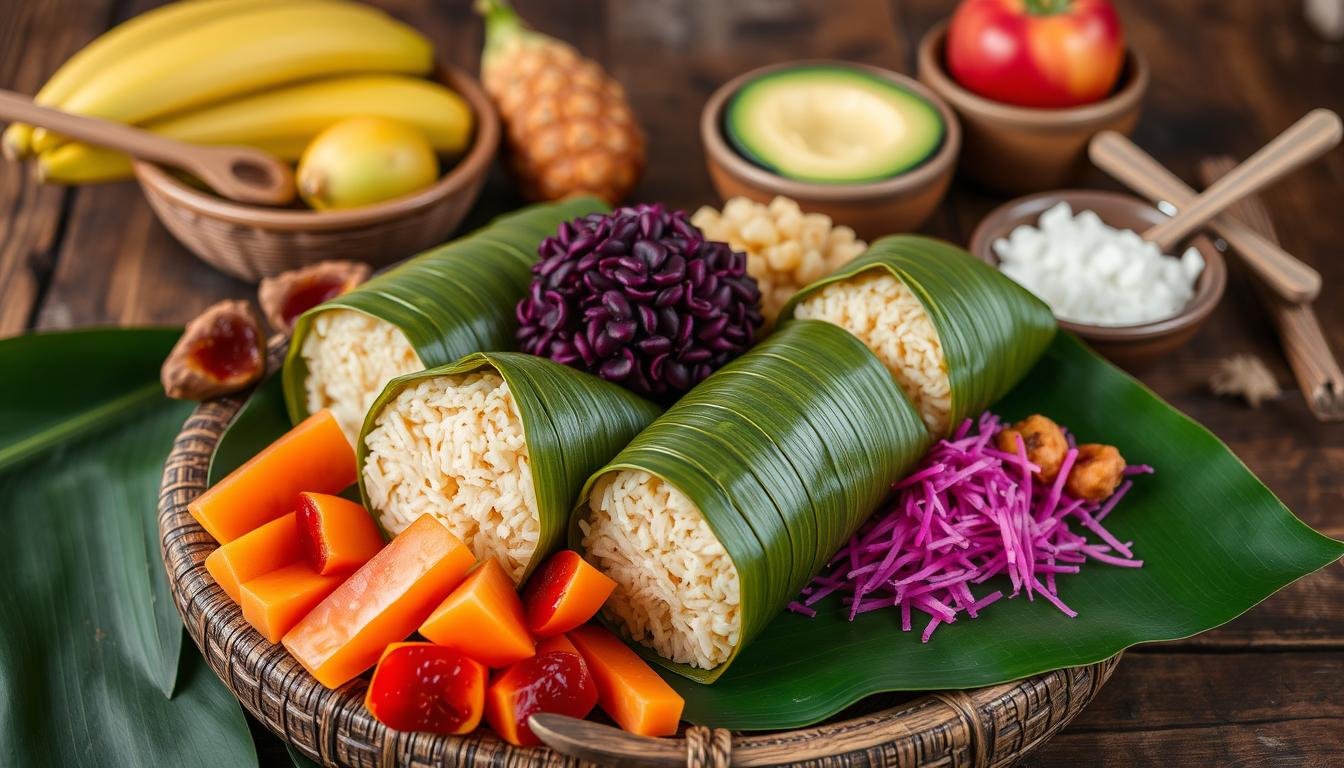Have you ever heard of binungey, the captivating rice cake loved by Filipinos? It’s a traditional treat that shows the creativity and cultural values of the Filipino people. But what makes binungey special, and why has it stood the test of time?
Key Takeaways
- Binungey is a traditional Filipino rice cake with a long history dating back to pre-colonial times.
- The name “binungey” originates from the Pangalatok word “nungey,” meaning “cooked in bamboo.”
- Binungey plays a significant role in Filipino culture, often served during local celebrations and festivals.
- Preparation of binungey involves filling bamboo tubes with sticky rice and coconut extract, then steaming for hours.
- Binungey is a beloved snack in Bolinao and is celebrated during the Anda’s Binongey Festival.
Ingredients and Preparation
Binungey is a beloved sticky rice dish from the Philippines. It’s made with glutinous rice, coconut milk, and spices. The key ingredients are glutinous rice, coconut milk, sugar, coconut cream, and salt.
Essential Ingredients
- Glutinous rice: Also known as sticky rice or sweet rice, this is the foundation of binungey, providing the characteristic chewy texture.
- Coconut milk: Extracted from the meat of mature coconuts, this creamy liquid adds richness and flavor to the dish.
- Sugar: A touch of sweetness is balanced with the use of sugar, complementing the natural flavors.
- Coconut cream: Thicker and richer than coconut milk, this ingredient adds a luxurious mouthfeel to the binungey.
- Salt: A small amount of salt is used to enhance the overall flavor profile.
Traditional Preparation
To make binungey, start by soaking the glutinous rice for a few hours. Then, fill bamboo tubes about three-quarters full with the rice. Pour coconut extract over the rice, covering it by about half an inch.
Grated coconut from the extraction is placed on top to prevent ash and dirt from reaching the rice mixture. The bamboo tubes are then steamed over a fire for 2-3 hours. It’s important to keep the fire at the right temperature to cook the binungey perfectly.
| Ingredient | Quantity | Nutritional Value |
|---|---|---|
| Glutinous rice | 2 cups | High in carbohydrates, provides energy |
| Coconut milk | 1 cup | Rich in healthy fats, vitamins, and minerals |
| Sugar | 1/2 cup | Provides sweetness and energy |
| Coconut cream | 1/4 cup | High in saturated fats, adds creaminess |
| Salt | 1/2 teaspoon | Enhances flavor and regulates fluid balance |
“The traditional preparation of binungey, with its careful steaming in bamboo over a fire, is a true testament to the art and craftsmanship of Filipino cuisine.”
The Art of Molding
In the world of binungey, molding is a mix of old and new. It uses bamboo and banana leaves for a rustic feel. But it also uses silicone and rectangular molds for a modern look. Each method gives binungey its own special touch.
Traditional Molding Techniques
Local craftspeople have made molding binungey an art form. They use bamboo tubes to shape the rice mixture. Then, they line these tubes with banana leaves for flavor and texture.
The mixture is steamed, creating binungey that shows off traditional craftsmanship.
Modern Molding Methods
Today, some makers use modern adaptations in molding binungey. They use silicone molds for their precise shapes. Rectangular molds also offer a modern look that people love.
Yet, the old ways of using bamboo and banana leaves are still cherished. They add a special touch to binungey. The mix of binungey molding techniques, bamboo molds, banana leaves, silicone molds, and rectangular molds shows the beauty of traditional craftsmanship and modern adaptations.

Toppings and Flavor Variations
The classic binungey is often topped with grated coconut and muscovado sugar. These add a nice crunch and a sweet caramel taste. They enhance the rice cake’s natural sweetness and texture.
Recently, binungey makers have introduced new flavor variations. They aim to attract more people and keep the treat fresh for younger fans. Some favorite new flavors include:
- Ube (Purple Yam) – This vibrant purple adds a unique taste to the traditional binungey. It keeps the cultural heritage alive.
- Pandan – Pandan leaves give the binungey a fragrant and floral flavor. It’s a delightful twist.
- Chocolate – Chocolate brings a rich and indulgent taste. It’s a modern take on the classic binungey, perfect for those who love sweets.
These modern adaptations of the binungey keep it exciting and relevant. They honor its traditional flavors and cultural importance.
“The beauty of binungey lies in its ability to evolve and adapt, while still maintaining its cultural roots. These flavor variations are a testament to the creativity and ingenuity of our local producers.”
Cultural Significance and Traditions
Binungey, a beloved sticky rice treat, is deeply rooted in Pangasinan culture. It’s a key part of local celebrations and festivals. The Binongey Festival in Anda, Pangasinan, is a big event where people come together to honor this rice cake.
Binungey is also tied to stories and legends passed down through generations. These tales add to the pride and respect for this culinary tradition. Making and sharing binungey is more than just eating. It’s a way to keep the region’s culture and heritage alive.
Binungey’s Role in Local Celebrations and Festivals
Binungey is a must-have at the Binongey Festival in Anda, Pangasinan. The festival shows the strong bond between the people and their favorite rice cake.
Stories and Legends Associated with Binungey
- Legends of how binungey was first created and its importance in Pangasinan culture
- Stories of how binungey has been passed down through generations, becoming a key part of Pangasinan identity
- Narratives that highlight the unique preparation methods and the pride the local community takes in this enduring tradition
Binungey’s cultural value goes beyond its taste. It’s a treasured part of Pangasinan heritage, woven into local celebrations and the community’s memory. Through stories and legends, the Pangasinan community keeps its rich traditions alive and celebrates their culinary legacy.

Enjoying Binungey
Binungey, a sweet rice treat, is loved as a snack. It’s often paired with coffee or hot chocolate. The rice cake’s mild sweetness goes well with coffee’s bold flavors or chocolate’s warmth.
This pairing is a favorite in Philippine cuisine. It brings comfort and joy to those who enjoy it.
Binungey is not just a snack. It also adds flavor to Filipino meals. It’s great with fresh mangoes or dipped in latik (coconut caramel) or muscovado sugar. This makes meals even more special.
Traditional Serving and Pairing
- Binungey is traditionally enjoyed as a snack, often served with a cup of hot coffee or chocolate.
- The mild, slightly sweet taste of binungey pairs well with the richness of the coffee or the warmth of the chocolate, creating a harmonious and comforting combination.
- Binungey can also be enjoyed as a component of larger Filipino meals, complementing the flavors of other traditional dishes.
- Common pairings include serving binungey with fresh mangoes or dipping it in local delicacies like latik (coconut caramel) or muscovado sugar.
Binungey’s versatility makes it a key part of Philippine cuisine. It’s a cherished part of the country’s cultural heritage and gastronomic landscape.
Conclusion
Binungey is a true gem of the Philippines’ culinary world. It has a rich history and deep cultural roots. This guide has shown you how to make binungey, from its ingredients to its cultural significance.
Whether you’re a pro in the kitchen or just starting out, try making binungey. It’s a fun way to connect with Filipino culture. By making and sharing binungey, we keep this tradition alive.
Learning to make binungey is more than just cooking. It’s about preserving our culinary heritage. As you make binungey at home, you’ll enjoy its unique taste. You’ll also help keep this important part of Philippine culture alive.
FAQ
What is binungey?
What are the essential ingredients for making binungey?
How is binungey traditionally prepared?
What are the traditional molding techniques for binungey?
What are some popular flavor variations of binungey?
What is the cultural significance of binungey?
How is binungey traditionally enjoyed?
Source Links
- Tasty Treasures Delightful Kakanin Adventures
- Bamboo + malagkit + gata = binungey – LANGYAW
- Tummy Teasers
- Experience the Taste of the North: Food and Gastronomy Tour in Pangasinan
- Seasonal Star Apple Desserts Across the Philippines – pinascuisine.com
- Alaminos , Pangasinan
- Pangasinan: The Salt-making Powerhouse of Northern Luzon
- Traditional Food Tripping Pangasinan
- Digging Up Culture
- Why we run for our culture – THEPHILBIZNEWS
- Sticky rice in bamboo
- Things to do in Bolinao in November – Wanderlog
- A return to Lingayen Gulf – BusinessWorld Online
